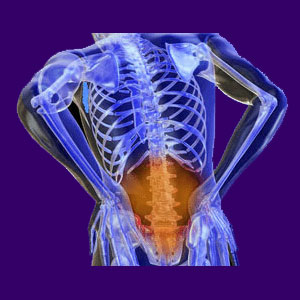
Scoliosis symptoms should really be called indicators, because the physical expressions of atypical side-to-side spinal curvature are mostly signs that the condition exists, rather than true symptoms that cause pain or discomfort. Over 90% of people with a minor spinal curvature do not have any pain or neurological symptoms, which should not be of any surprise. Remember, scoliosis is not an inherently painful condition.
The reason why most patients do not feel any pain from unusual spinal curvatures is that most are mild to moderate in severity and produce no definitively negative effects on the anatomy. In cases where scoliosis is severe or extreme, the chances for painful expressions increase drastically. This is not to say that all severe spinal curves will definitely cause pain, since some do not. However, as curvature worsens on the diagnostic scale, the chances for many problematic occurrences rises exponentially. Some of the worst of these potentially symptomatic issues include pinched nerve pain, central spinal stenosis pain, mechanical back pain conditions, organ compression and vascular tissue damage.
This objective essay explores the variety of possible symptoms of scoliosis, as well as provides data to support the fact that most cases are not symptomatic to any significant degree.
Severe Scoliosis
Severe spinal curvature (over 70 degrees) can cause the ribs to constrict the lungs and heart. Damage can be done to internal organs that do not have the required room to function correctly. The patient might have difficulty breathing and is at heightened risk for pneumonia.
This form of extreme curvature almost always requires professional scoliosis treatment. Although the therapy options are not ideal, they are still the best medicine can offer at this point in time. Typically, spinal fusion surgery is suggested for ultra-problematic curvatures. Truly disabling scoliosis is one of the times where the treatment for the curvature might be just as bad as the condition itself, placing patients between a rock and a hard place when seeking medical care.
Scoliosis Symptoms and Signs
Below are listed some of the most common symptoms, indicators of an abnormal scoliotic curvature. As noted above, most of these indicators will not cause pain, nor should they create physical dysfunction:
Shoulder height may not be uniform from left to right.
One or both shoulders may project to the front or back.
Patient may demonstrate uneven waist or hip height left to right.
Patient may demonstrate uneven leg lengths.
Patient may have more prominent ribs on one side of the body.
Patient may demonstrate obvious or subtle lean to one side.
Patient might feature prominent or uneven shoulder blades.
All of these criteria should be considered when diagnosing scoliosis.
Recognition of Scoliosis Symptoms
Scoliosis is not usually a condition that causes pain. Most people that have spinal curvature do not require any special treatment. If the curve is mild as a child nears adulthood, it is rare that it will deteriorate any further. It is important to understand the mostly innocent nature mild to moderate scoliosis, since the nocebo effect of the diagnostic process can lead to the start of pain conditions through a purely mindbody process. This can cause symptoms when none might otherwise be experienced.
I can tell you for sure how frightening it is for a young person to be diagnosed and purposefully filled with myths about the true nature of atypical spinal curvature. I lived this nightmare myself and will never forget the cruel manner in which my chiropractor explained the horrors of this condition simply to scare me and my family into ongoing care. It was unconscionable.
Severe spinal curves should be treated long before they pose a health risk to the person. All spinal curves should be monitored by a scoliosis specialist who can ensure that treatment can be provided when and if it is ever required.





